Supplements for Perfect Skin
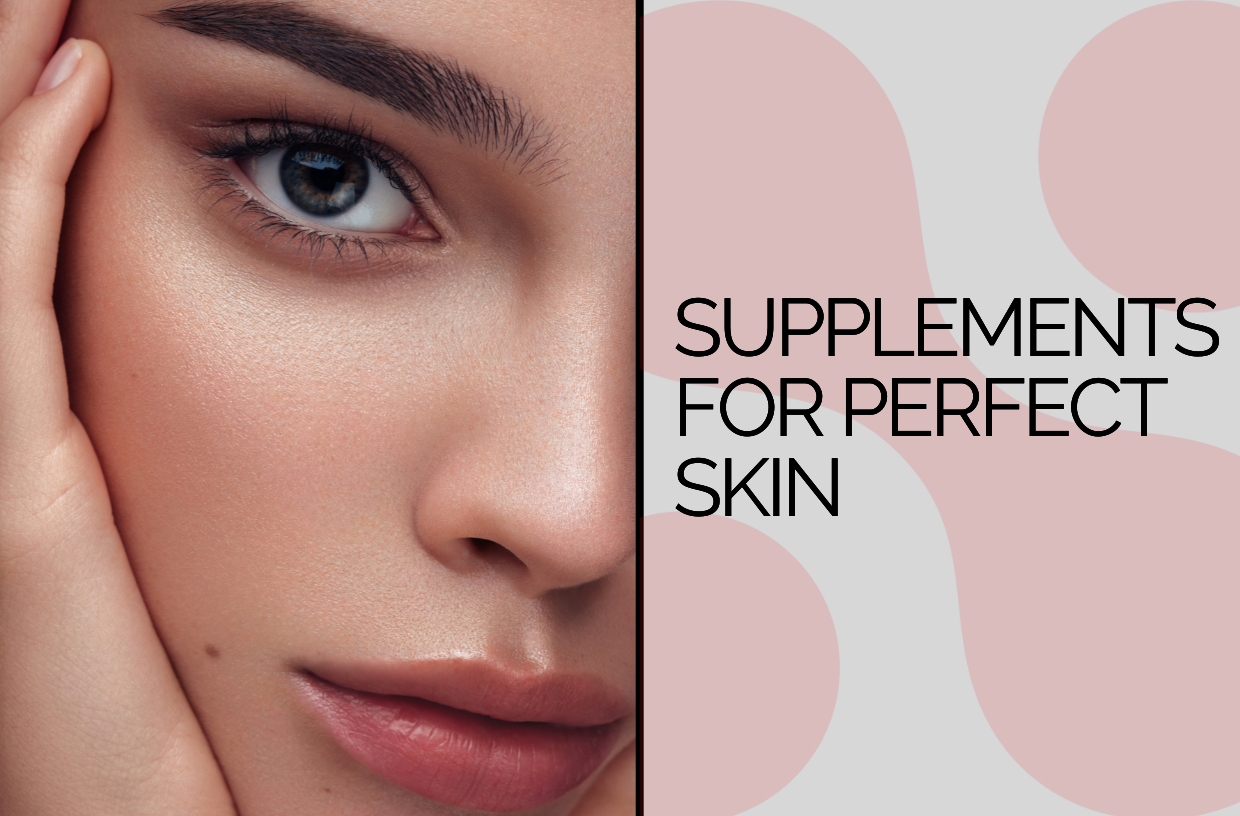
Skin care was traditionally something relegated to only facial creams and potions, but there are now many oral supplements on the market that can help combat the signs of aging and improve the skin’s appearance.
In fact, skin supplements have become a large and growing industry worldwide. Sometimes referred to as cosmeceuticals, beauty supplements or ingestible skin care, these products are aimed at improving wrinkles, skin tone and elasticity and reducing sagging and even sun damage. According to InsightAce Analytic, the global ingestible beauty market size was valued at $3.3 billion USD in 2021 and is projected to reach $8.30 billion USD by 2030.1
At this rate, you can be sure there will be no shortage of skin supplements to choose from. Just as in the sports nutrition category, there will be good and not-so-good supplements that may or may not live up to the hype. Skin supplements include a wide variety of fruit and green extracts, antioxidants, vitamins, collagens and more. Not sure which ones to choose from? We’re reviewing some of the most common and not-so-common supplements for skin.
Tremella
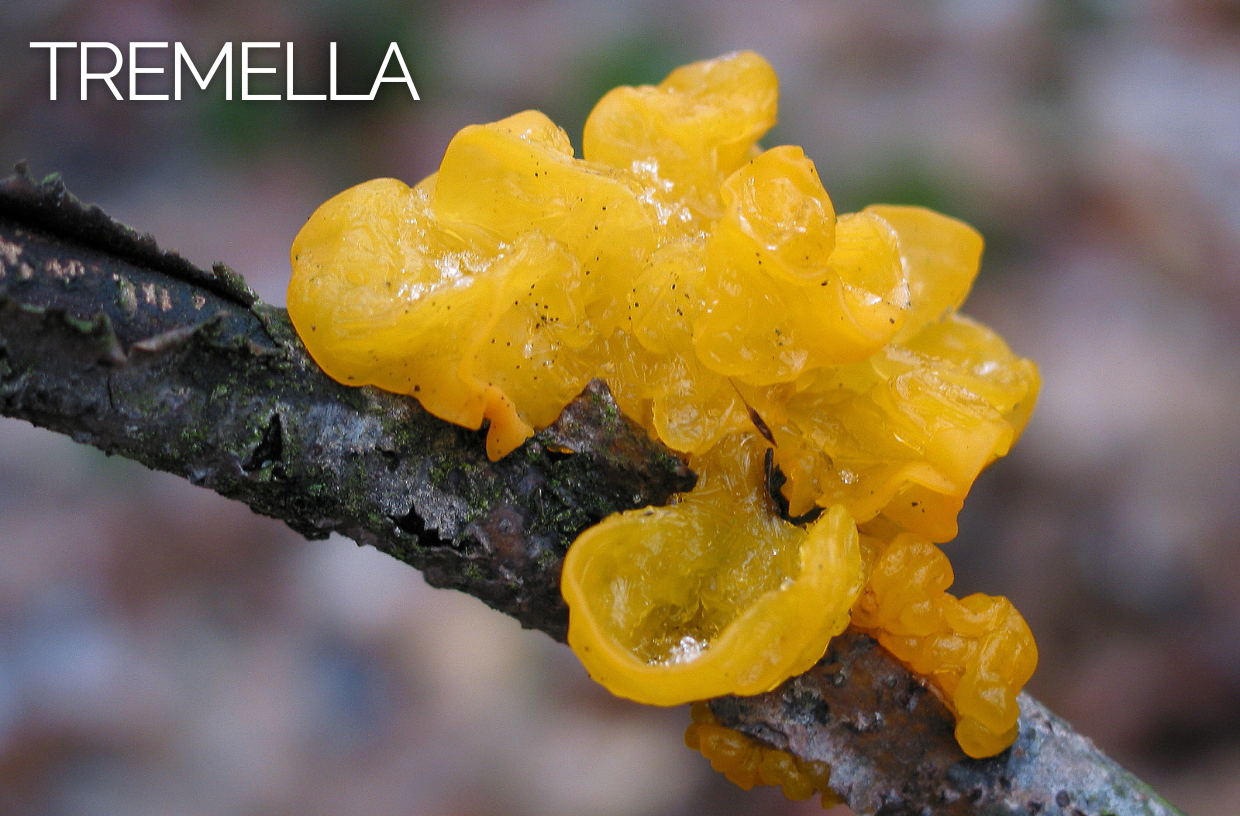 Tremella fuciformis, also known as snow mushrooms, have been traditionally used in Chinese medicine for its skin-boosting benefits. The active ingredient in Tremella, polysaccharides, has been shown to have skin hydrating, antioxidant, anti-inflammatory and anti-aging effects.2
Tremella fuciformis, also known as snow mushrooms, have been traditionally used in Chinese medicine for its skin-boosting benefits. The active ingredient in Tremella, polysaccharides, has been shown to have skin hydrating, antioxidant, anti-inflammatory and anti-aging effects.2
The antioxidant properties of polysaccharides include a scavenging effect on hydroxyl and superoxide radicals that have ion-reducing ability.2 Hydroxyl radicals can cause DNA and protein damage, leading to skin injury and signs of aging. Tremella polysaccharides can therefore help protect and promote regeneration of skin structure.
One study showed that Tremella polysaccharides at concentrations ranging from 100 to 200 µg/mL had excellent antioxidative and cell protective functions.2 Tremella polysaccharides markedly reduced hydrogen peroxide-induced skin fibroblast injury through suppression of reactive oxygen species (ROS) production and cell apoptosis.2
In histopathological studies, oral Tremella polysaccharides can promote the regeneration of endogenous collagen and maintain the ratio of collagen type I/III to protect skin structure from damage caused by UV rays.3 Tremella polysaccharides can also significantly promote skin wound healing in animal models.4
Tremella has promise as an effective skin supplement that could be taken on its own or added to collagen or protein drinks.
Collagen
 Collagen is the most important protein when it comes to skin structure. Collagen is the glue that holds the skin together, keeping it firm, tight and hydrated. As the body ages, it produces less collagen and lower quality collagen, thus reducing the skin’s structure, firmness and moisture, resulting in sagging skin and the formation of wrinkles. Collagen supplementation can stimulate collagen production by promoting the production of the skin’s structural proteins, elastin and fibrillin.
Collagen is the most important protein when it comes to skin structure. Collagen is the glue that holds the skin together, keeping it firm, tight and hydrated. As the body ages, it produces less collagen and lower quality collagen, thus reducing the skin’s structure, firmness and moisture, resulting in sagging skin and the formation of wrinkles. Collagen supplementation can stimulate collagen production by promoting the production of the skin’s structural proteins, elastin and fibrillin.
In a double-blind placebo-controlled trial, 69 women between 35 and 55 years of age who consumed between 2.5 and 5 grams of collagen peptides or placebo once daily for 8 weeks showed significant improvements in skin elasticity compared to those who took a placebo.5
In two placebo-controlled clinical trials, collagen peptide supplementation for 4 weeks increased collagen density in the skin, while fragmentation of the dermal collagen decreased. After 8 weeks of collagen supplementation, skin hydration significantly improved.6
Another study found that women who drank a beverage mixed with a supplement including ingredients that support collagen production daily for 12 weeks experienced increased skin hydration and a significant reduction in wrinkle depth compared with a control group.7 The collagen product significantly improved skin hydration, elasticity, roughness and density.7 The differences between the supplement group and the placebo group were statistically significant for all test parameters.7
Research supports the use of collagen for rebuilding collagen in the skin. Perhaps one drawback of collagen supplementation is the large dose required, up to 5 grams per day. This should be consumed as a collagen creamer, collagen shot or powder mixed with your favorite beverage.
Resveratrol
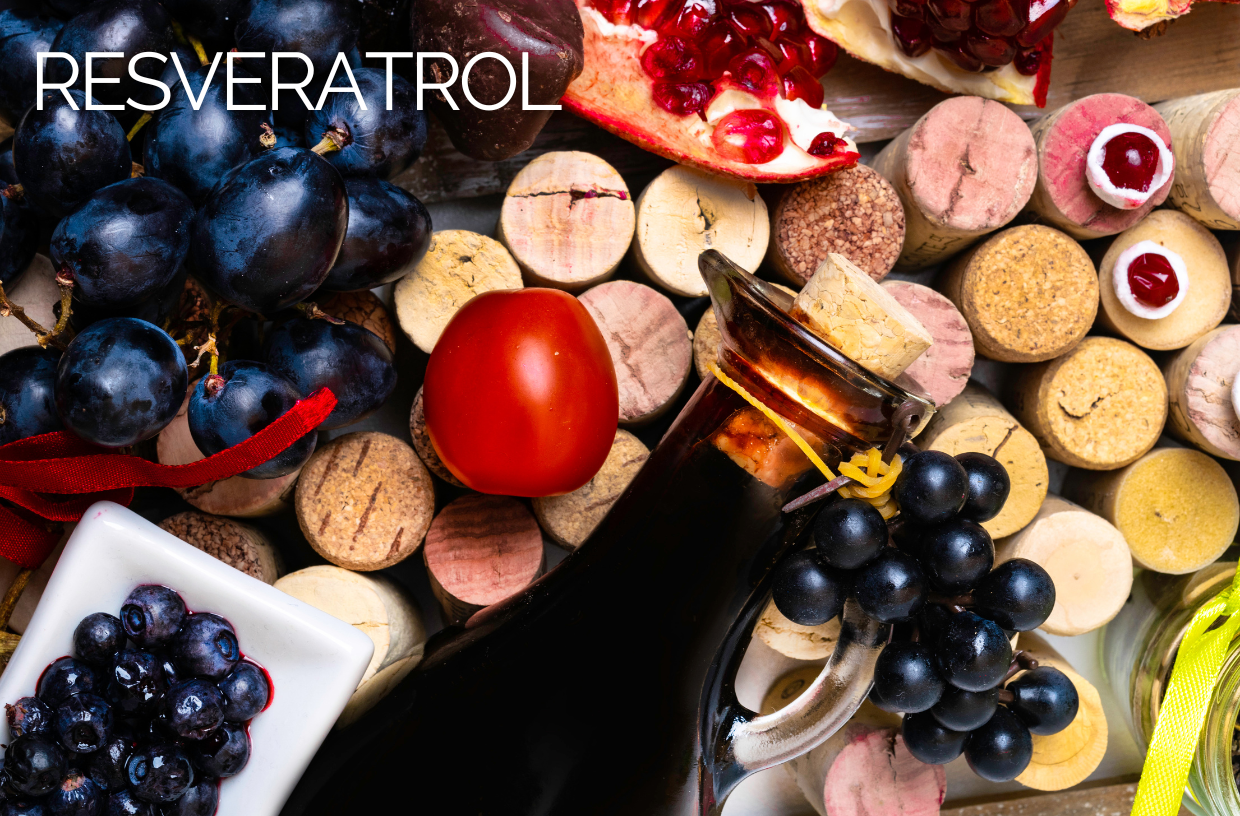 Resveratrol is a polyphenol and the active compound found in berries, red wine and grapes. The skin-protecting and anti-aging mechanism by which resveratrol and its derivatives work is by attenuating photoaging and inflammation, increasing blood flow and providing antioxidant activity, scavenging hydroxyl radicals, nitric oxide and superoxide anion.8
Resveratrol is a polyphenol and the active compound found in berries, red wine and grapes. The skin-protecting and anti-aging mechanism by which resveratrol and its derivatives work is by attenuating photoaging and inflammation, increasing blood flow and providing antioxidant activity, scavenging hydroxyl radicals, nitric oxide and superoxide anion.8
In one clinical study, 50 volunteers received a dietary supplement of grape extract that was rich in resveratrol and procyanidins for 60 days.9 The dosage received was 133 milligrams of grape extract, providing 8 milligrams of resveratrol and 15 milligrams of procyanidins. After 60 days of treatment, systemic oxidative stress decreased, while skin roughness and wrinkling also reduced. Results also showed that skin moisture and elasticity had improved with supplementation.9
Resveratrol may not just function as an antioxidant but also induce expression of several antioxidant enzymes. Furthermore, it appears to interact with receptors and kinases associated with aging, specifically, sirtuin (SIRT) and nuclear factor-kappa B (NF-κB), which both influence regulation of metabolic processes across multiple tissues.8 SIRT can influence skin healing, including collagen organization, while downregulation of NF-κB may help prevent photo aging or hyperpigmentation.
Resveratrol can be supplemented on its own or can be found combined with other antioxidants. Resveratrol should be in the trans form, and is usually from grapes or Japanese knotweed.
Coenzyme Q10
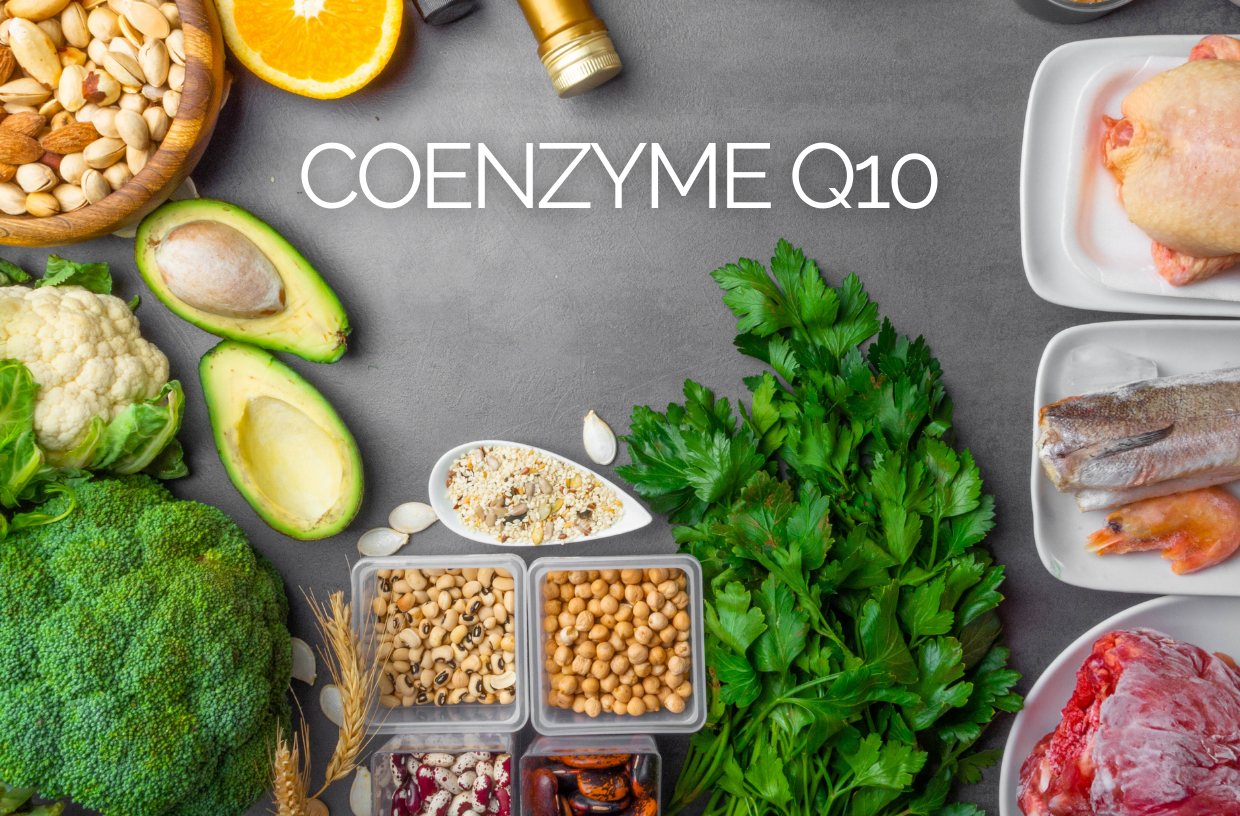 Coenzyme Q10 (CoQ10) is an antioxidant compound and a major component of the skin. CoQ10 can be found in both cells of the dermis and epidermis and is a constituent of the skin surface lipids (SSL) of the stratum corneum. Studies have suggested that CoQ10 levels in the skin and SSL decline with age and UV exposure and are a major cause of skin aging.10 Supplementing with CoQ10 has evidence to suggest it may help increase bioavailability of CoQ10, reduce wrinkles and improve the texture of the skin.
Coenzyme Q10 (CoQ10) is an antioxidant compound and a major component of the skin. CoQ10 can be found in both cells of the dermis and epidermis and is a constituent of the skin surface lipids (SSL) of the stratum corneum. Studies have suggested that CoQ10 levels in the skin and SSL decline with age and UV exposure and are a major cause of skin aging.10 Supplementing with CoQ10 has evidence to suggest it may help increase bioavailability of CoQ10, reduce wrinkles and improve the texture of the skin.
In one study on healthy females between 45 and 65 years of age, those who consumed a combination of CoQ10 (50 milligrams) and fish collagen (4 grams) for 12 weeks reported having improved skin parameters including skin tone, wrinkles and dryness.11 Another study showed similar results, where female volunteers were given 50 or 150 milligrams per day of CoQ10 for 12 weeks.12
A significant reduction in periorbital wrinkles and microrelief lines as well as improved skin smoothness with both doses was seen, whereas the higher dose led to additional improvement of wrinkles in other facial parts.12
In addition to improving visible skin parameters, CoQ10 has also been shown to have an impact on mitochondrial respiration and ATP production in epithelial tissue in human skin biopsies.13 CoQ10 administration may also have an anti-inflammatory function, providing protection against UVA/B-irradiation.14 Furthermore, CoQ10 dose-dependently can enhance elastin and collagen gene expression, as well as cell proliferation in adult fibroblasts and inhibited ROS production.14
CoQ10 can be purchased at various dosages, ranging from 50 to 200 milligrams. CoQ10 has low absorption, so supplement with high-absorption CoQ10 formulated with ingredients to help increase its delivery.
Glutathione
 Glutathione is a thiol antioxidant produced in the cells in the body and is composed of three amino acids: glycine, cysteine and glutamine. Increasing glutathione via supplementation has been suggested to reduce pigmentation of the skin, helping reduce the signs of aging.15
Glutathione is a thiol antioxidant produced in the cells in the body and is composed of three amino acids: glycine, cysteine and glutamine. Increasing glutathione via supplementation has been suggested to reduce pigmentation of the skin, helping reduce the signs of aging.15
The production of melanin in melanocytes induced by UV radiation generates ROS, which contributes to oxidative damage of DNA. The formation of ROS and oxidative damage and/or the repair of damage produces important signals that stimulate melanogenesis, which is the formation of melanin.16 Cellular antioxidant systems, including the glutathione system, function to maintain an optimal redox balance in melanocytes by quenching ROS and protecting against oxidative stress, excessive melanogenesis and photo-damaged skin.16
Supplementation of glutathione at doses of 500 milligrams per day for 4 and 8 weeks has been shown to be effective for lightening skin color, while also reducing melanin index and having fewer UV spots at both sun-exposed and sun-protected skin areas.17,18,19 These studies support the potential of glutathione for skin lightening and the treatment of hyperpigmentation.
Glutathione should be supplemented in the reduced form, which is the active state. Other forms of glutathione are liposomal, which encapsulates glutathione, ensuring better absorption and delivery. Glutathione in these formats can be up to double the price of regular glutathione.
Vitamin C
 This water-soluble vitamin has a wide range of benefits when it comes to healthy skin. Normal skin contains high concentrations of vitamin C, which supports important and well-known functions, including stimulating collagen production, increasing skin cells, keratinocyte differentiation and assisting in antioxidant protection against UV-induced photo damage.20 Aging skin and skin that has experienced UV damage and exposure to the elements has lower concentrations of vitamin C.
This water-soluble vitamin has a wide range of benefits when it comes to healthy skin. Normal skin contains high concentrations of vitamin C, which supports important and well-known functions, including stimulating collagen production, increasing skin cells, keratinocyte differentiation and assisting in antioxidant protection against UV-induced photo damage.20 Aging skin and skin that has experienced UV damage and exposure to the elements has lower concentrations of vitamin C.
Studies have shown that supplementing with vitamin C can increase the skin’s vitamin C content. One study showed that the keratinocyte vitamin C concentration doubled upon supplementation of 3 grams per day of vitamin C for six weeks, achieving plasma saturation.21 Dietary supplementation of vitamin C may be most effective in those that have below saturation plasma levels.
In one study, daily supplementation of vitamin C for four weeks in healthy men and women (22 to 50 years of age) improved oxygen radical scavenging.22 After 4 weeks, the intake of 100 milligrams per day of vitamin C resulted in a significant increase in the radical-scavenging activity by 22 percent. Intake of milligrams per day resulted in a significant increase of 37 percent.22
In vitro studies on human skin cells have shown that vitamin C can increase collagen formation, keratinocyte and barrier formation, ceramide, antioxidant status and resistance to UV exposure20. Vitamin C can also provide protection against hyperpigmentation, photoaging, wrinkle formation, skin sagging and roughness, and can prevent dry skin20.
Vitamin C is available in multiple forms: combined with natural sources of vitamin C, in time-released format, as powder or even in chewable supplements. Because vitamin C is water soluble, larger doses can be considered.
Vitamin A
 Vitamin A is a fat-soluble essential nutrient that is involved in the skin’s immune response and protection through its retinoid derivatives. Retinoids control gene expression through retinoic acid receptors, which are transcription factors expressed by the skin cells that mediate expression of target genes.23
Vitamin A is a fat-soluble essential nutrient that is involved in the skin’s immune response and protection through its retinoid derivatives. Retinoids control gene expression through retinoic acid receptors, which are transcription factors expressed by the skin cells that mediate expression of target genes.23
Retinol also acts as an anti-aging agent by interacting with receptors inside skin cells, promoting their proliferation, strengthening the epidermal protective function, reducing trans-epidermal water loss, protecting collagen against degradation and inhibiting the activity of metalloproteinases, which are responsible for degradation of the extracellular matrix.24
Supplementation with vitamin A isn’t nearly as effective as application directly to the skin using its derivatives retinol or retinoic acid. However, this application is still limited because vitamin A and its derivatives are irritants to the skin.
Topical vitamin A and its derivatives have been used to improve skin function and boost production of epidermal proteins and skin cell formation. They can also block differentiation and cellular divisions of sebocytes, reducing sebaceous gland excretion.24 Vitamin A has also been shown to reduce discoloration of skin, reducing pigmentation, as well as stimulating collage production, improving skin elasticity and reducing wrinkling.24
Vitamin A should be supplemented in a softgel format for better absorption. It can be combined with other fat-soluble vitamins such as D and E, or with essential fatty acids. Oral supplementation will have limited effect and should be combined with a topical solution.
Vitamin E
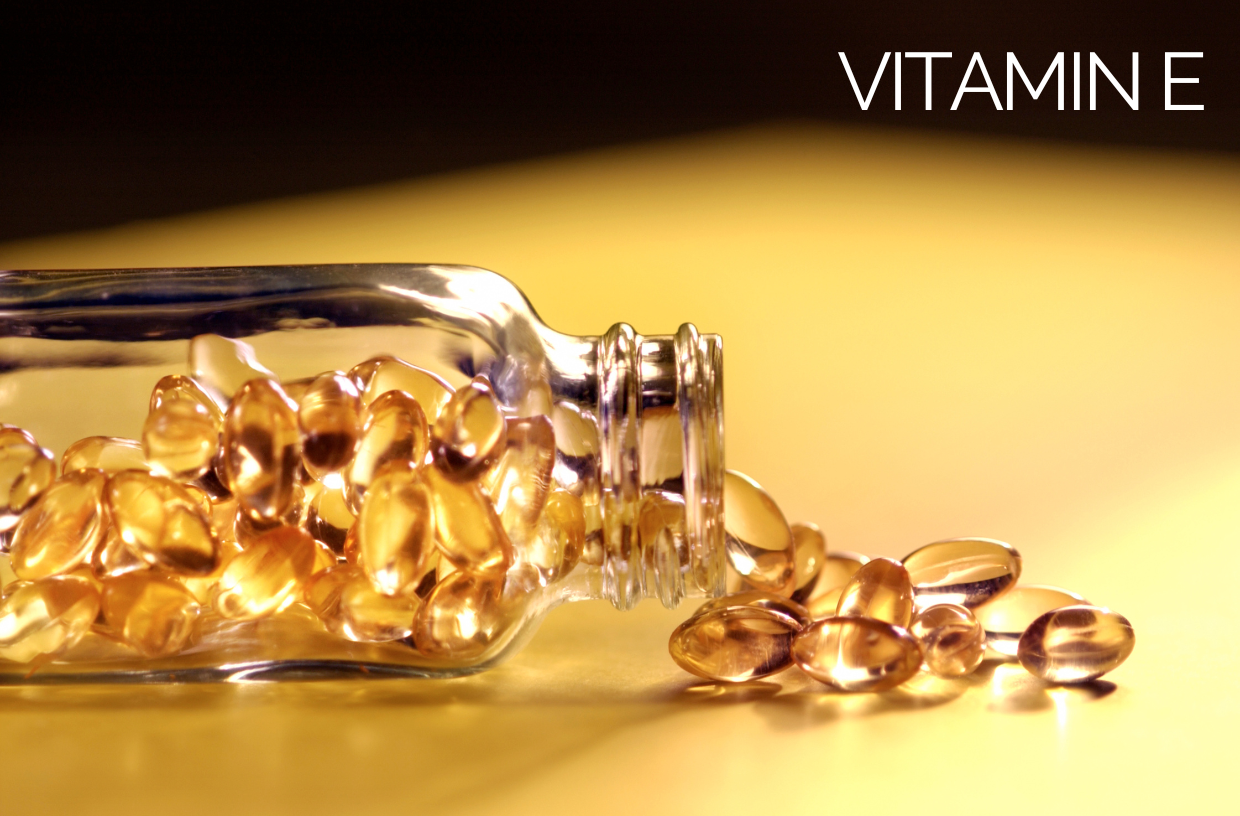 Vitamin E is another fat-soluble vitamin that plays a role in skin health. Vitamin E can be divided into two groups, tocopherols and tocotrienols, with four isomers (alpha, beta, gamma and delta). In general, vitamin E serum levels are lower in individuals with chronic inflammatory skin diseases such as vitiligo, psoriasis, dermatitis and acne.25
Vitamin E is another fat-soluble vitamin that plays a role in skin health. Vitamin E can be divided into two groups, tocopherols and tocotrienols, with four isomers (alpha, beta, gamma and delta). In general, vitamin E serum levels are lower in individuals with chronic inflammatory skin diseases such as vitiligo, psoriasis, dermatitis and acne.25
Vitamin E has potential as adjuvant therapy for various skin disorders because of its antioxidant and anti-inflammatory properties. Vitamin E supplementation has resulted in the significant improvement of clinical conditions and normalization of oxidative stress markers in patients with psoriasis and vitiligo.25
Two randomized, double-blind, placebo-controlled clinical trials concluded that alpha-tocopherol increased erythrocyte superoxide dismutase activity and reduced the Scoring Atopic Dermatitis (SCORAD) index in patients with atopic dermatitis (AD).26,27 These studies suggest that vitamin E can improve the symptoms and the quality of life in patients with AD at an oral dosage of 400 IU per day.27
Vitamin E can be found as D-alpha-tocopherol or mixed tocopherols. The softgel format for maximal absorption at a minimum of 400 IU per day is best.
Puremidine
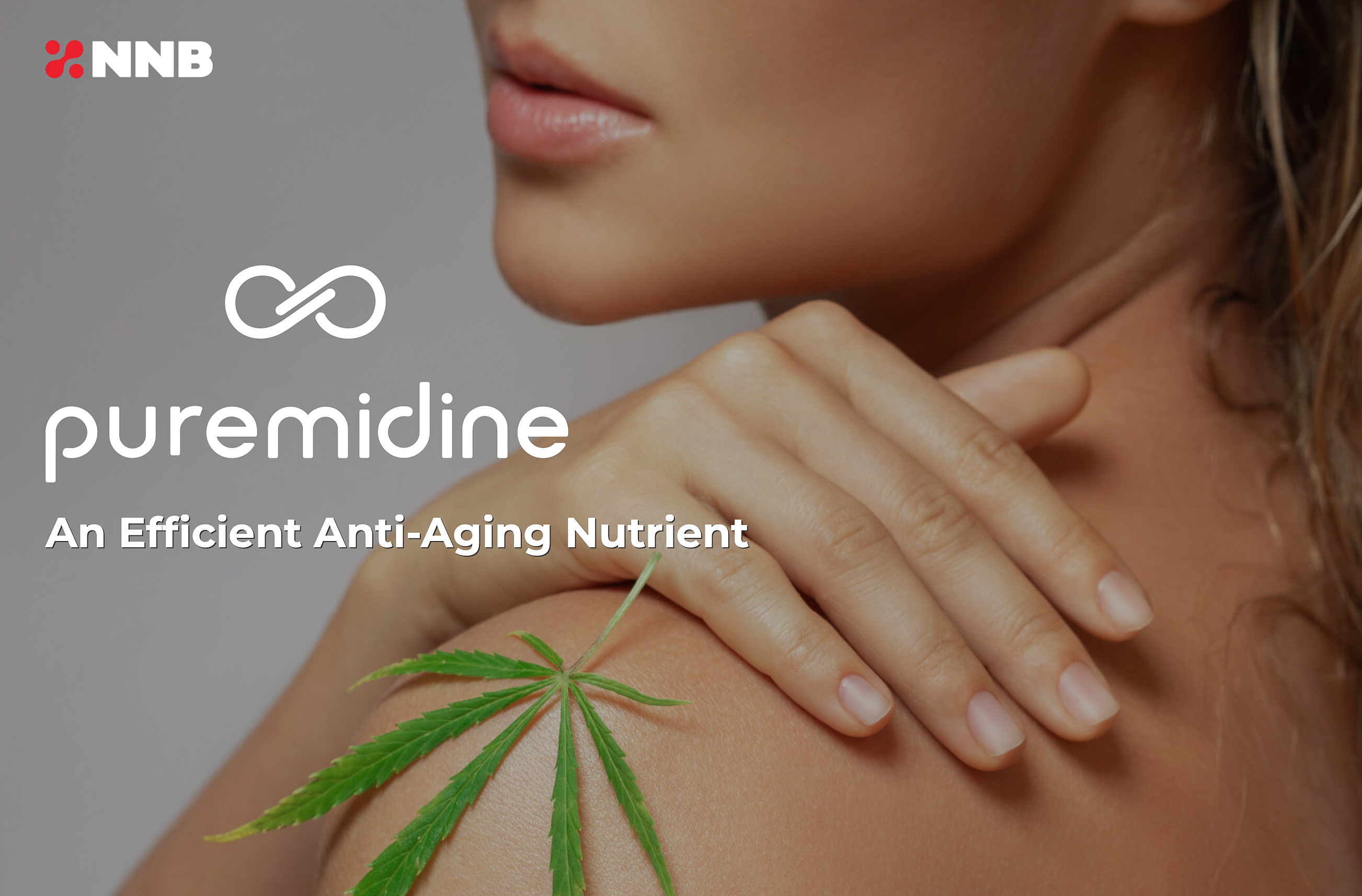 Puremidine, from NNB Nutrition, is a pure, high-quality form of the active ingredient spermidine. Spermidine belongs to the group of organic compounds called polyamines, along with spermine and putrescine. Polyamines are polycations, which means they have more than two amino groups and can readily interact with negatively charged molecules such as DNA, RNA, proteins and lipids.28
Puremidine, from NNB Nutrition, is a pure, high-quality form of the active ingredient spermidine. Spermidine belongs to the group of organic compounds called polyamines, along with spermine and putrescine. Polyamines are polycations, which means they have more than two amino groups and can readily interact with negatively charged molecules such as DNA, RNA, proteins and lipids.28
Polyamines can play multiple roles in DNA stability, cell growth and proliferation, as well as cell survival and death.28 Spermidine is considered the most abundant polyamine in human tissues, and research suggests that increasing spermidine intake may slow the aging process and promote longevity.
When it comes to skin health, spermidine was found to recover reduced gene expression in aged skin cells exposed to UV, including collagen, elastin and fibrillin expression, as well as lipid synthesis.29 It’s suggested that spermidine may act as a transcriptional activator.
Although there’s a limited amount of research on spermidine for skin supplementation, spermidine shows promise as an anti-aging antioxidant supplement for promoting skin regeneration, reducing cell mortality and inflammation and promoting cell stability. Spermidine can be supplemented safely at 1.2 milligrams per day, taken on its own or combined with other ingredients for skin health and anti-aging.
Greens Powder
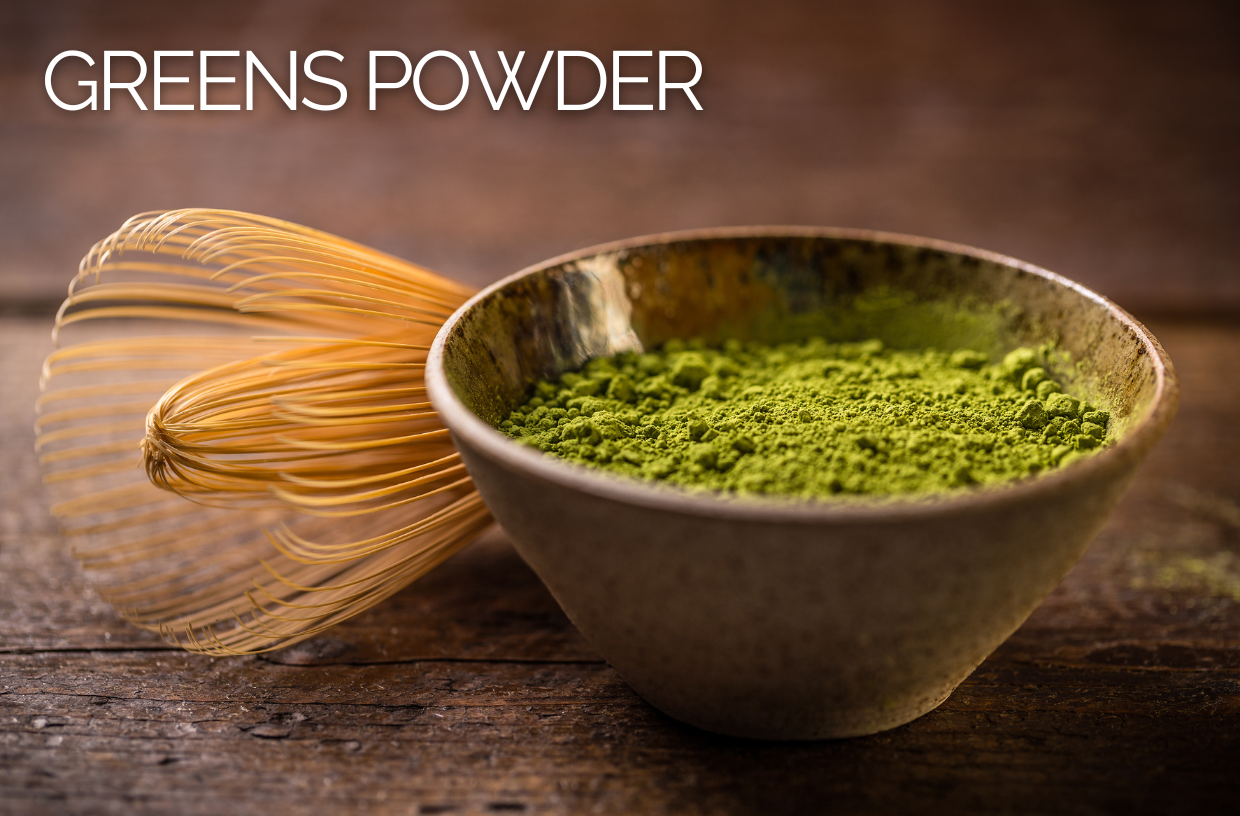 Greens powder supplements provide a variety of ingredients, including concentrated doses and extracts of vegetables and fruits. These plant compounds provide a natural source of antioxidants in the form of various polyphenols, thiols, vitamins and carotenoids. These compounds can have a direct effect on skin health, depending on their formulation and concentration of ingredients. Studies have shown that increased consumption of vegetables and fruit can increase antioxidant status.30
Greens powder supplements provide a variety of ingredients, including concentrated doses and extracts of vegetables and fruits. These plant compounds provide a natural source of antioxidants in the form of various polyphenols, thiols, vitamins and carotenoids. These compounds can have a direct effect on skin health, depending on their formulation and concentration of ingredients. Studies have shown that increased consumption of vegetables and fruit can increase antioxidant status.30
In one study, supplementation of a greens powder for 4 weeks showed the absorption and presence of major polyphenols and metabolites of flavonoids in blood plasma.31 The results of the in vivo part of the study suggest that one or more of these phytochemicals in the greens powder are well absorbed, retain their antioxidant properties and lower oxidative stress at an intake level of 6 teaspoons per day for 4 weeks.31
Although greens powders may have some positive effects on skin health via antioxidant status, it may be more efficient to supplement with the individual components that provide polyphenols and natural phytocompounds and vitamins that have directly been associated with skin health. When supplementing with greens powder, be sure the product is free from added fillers, sugar, and soy and uses high-quality, concentrated doses of ingredients.
MitoPrime
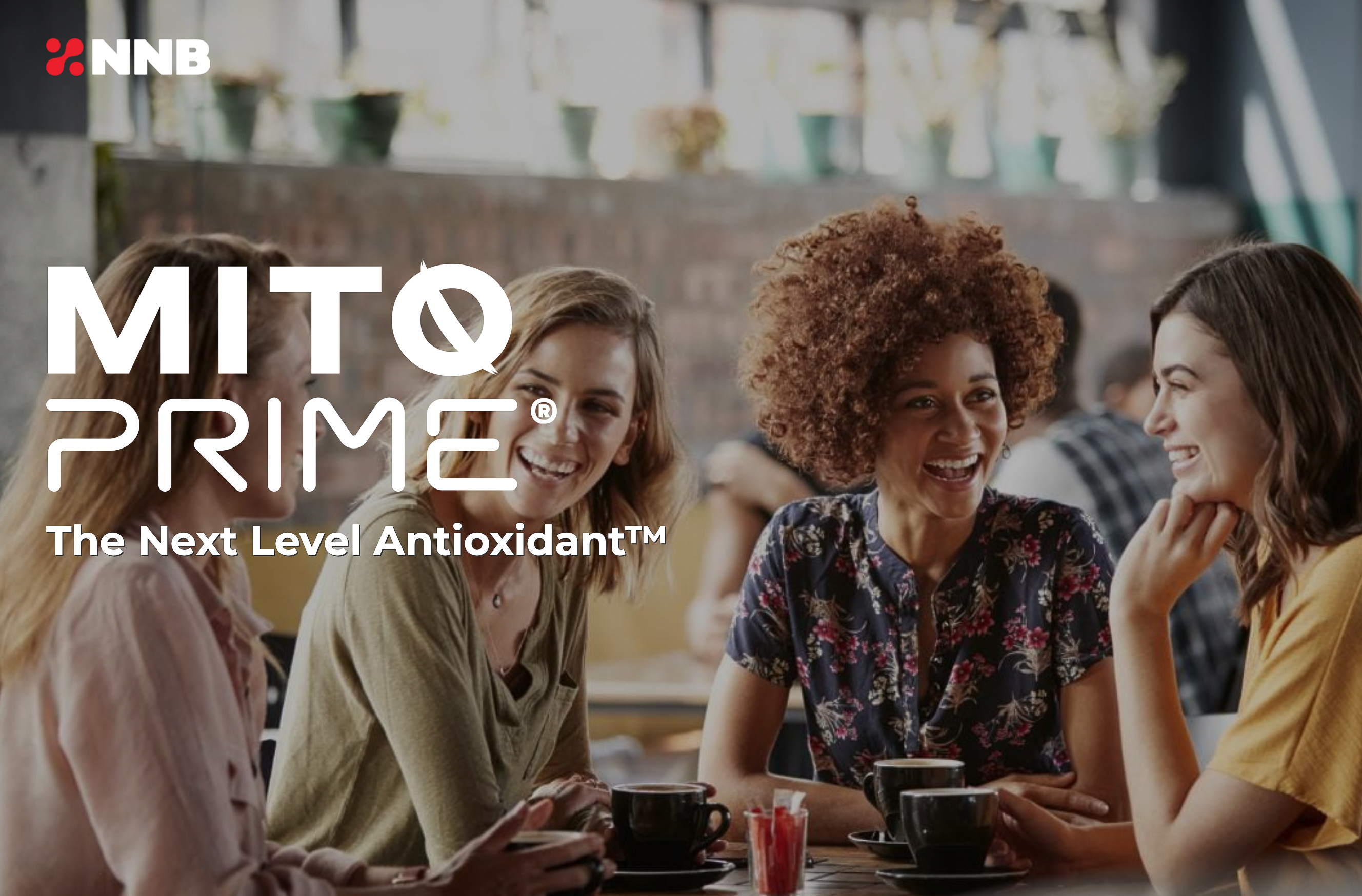 MitoPrime, formulated by NNB Nutrition, is the thiol antioxidant L-ergothioneine (ET) and is considered an anti-aging super-antioxidant. ET is naturally present in the body, but levels start to decline with age, as is evident with increased turnover and altered ET transporter (ETT) function.
MitoPrime, formulated by NNB Nutrition, is the thiol antioxidant L-ergothioneine (ET) and is considered an anti-aging super-antioxidant. ET is naturally present in the body, but levels start to decline with age, as is evident with increased turnover and altered ET transporter (ETT) function.
ET is concentrated in cells and tissues that have high oxidative stress and can move throughout the body via ETT to where high rates of oxidation occur. ET scavenges reactive oxygen, nitrogen and chlorine species, protecting cells from damage.32 When it comes to anti-aging, ET can protect mitochondrial DNA from oxidative damage. It can also work as a senolytic, destroying senescent or old and dying cells in tissues rejuvenating the tissue.33
In skin modelling studies, ET has been shown to prevent mitochondrial DNA deletion caused by UV exposure, while also helping repair damage.34 ET was also shown to suppress skin cell senescence, increase skin cell mitochondrial biogenesis, increase collagen formation and prevent collagen breakdown, while also reducing skin inflammation.35 ET was also shown to activate skin antioxidant genes, helping prevent future skin damage.
ET is extremely resistant to oxidation and a more active scavenger of free radicals than other antioxidants mentioned in this list, including vitamin C, CoQ10 and glutathione, which are oxidized more quickly.36 One study showed that ET was found to eliminate all oxidants up to 3000 percent better than glutathione and decreases lipid peroxidation 200 percent better than glutathione.37 Compared with CoQ10, ET was more than twice as effective when cells were exposed to a toxin and analyzed for their ability to limit lipid peroxidation. A study found ergothioneine was 270 percent better than CoQ10.38
If you’re considering supplementing with ergothioneine, look for NNB Nutrition’s MitoPrime, a premier form of L-ergothioneine. It’s extracted using a patented technology to produce a highly bioavailable L-isomer form of ergothioneine that is 100 percent pure and all natural, with GRAS status. MitoPrime is also effective at a low dose of 5 to 15 milligrams and can be found in gummies, combined with other ingredients or taken on its own.
MitoGreens
 MitoGreens combines the power of plant superfoods with MitoPrime. MitoGreens, also from NNB Nutrition, delivers 29 plant-based superfood ingredients that each provide unique phytocompounds, antioxidants and vitamins that can help support skin health and longevity.
MitoGreens combines the power of plant superfoods with MitoPrime. MitoGreens, also from NNB Nutrition, delivers 29 plant-based superfood ingredients that each provide unique phytocompounds, antioxidants and vitamins that can help support skin health and longevity.
MitoGreens provides a blend of fruits and berries, including grape seed extract. As already discussed, grape seed extract provides protection against photoaging and inflammation and can help improve blood flow in the skin.
MitoGreens also includes a vegetable blend including the cruciferous vegetables broccoli, brussels sprouts, broccoli sprouts and kale. These veggies are rich in the antioxidant vitamins C and E, which play key roles in skin cell formation, collagen production and reducing inflammation of the skin. Intake of cruciferous vegetables can also help prevent oxidative stress, induce detoxification enzymes, protect DNA from methylation and help with hormone metabolism.39
In addition to these phytocompounds and antioxidants, MitoGreens also provides the benefits of L-ergothioneine. This super anti-aging antioxidant can outperform vitamin C, CoQ10 and glutathione, decrease ROS, provide protection against UV exposure, increase collagen expression and decrease collagen breakdown.34,35 It’s also been shown to have 10 times more antioxidant capacity than the polyphenols in fruit and vegetables.
Unlike other greens powders, MitoGreens provides ultra-concentrated ingredients within a 100-milligram dose. MitoGreens has a high ORAC and is non-GMO and gluten free. It can be found combined with other greens powders or within gummies or capsules.
Choosing the Best Skin Supplements
 When considering skin health, supplement selection will be individual and dependent on many different factors, including age, nutrient availability, UV exposure, hormone levels, microbiome balance and any underlying skin condition. Although many ingredients in skin supplements can be obtained from the diet, extracts and super-antioxidants can deliver more potent and effective benefits.
When considering skin health, supplement selection will be individual and dependent on many different factors, including age, nutrient availability, UV exposure, hormone levels, microbiome balance and any underlying skin condition. Although many ingredients in skin supplements can be obtained from the diet, extracts and super-antioxidants can deliver more potent and effective benefits.
In this review, we’ve included a few of NNB Nutrition’s unique supplements, including MitoPrime, MitoGreens and Puremidine. These branded ingredients provide antioxidants that can support skin health but also promote rejuvenation and longevity. NNB Nutrition’s unique ingredients at concentrated doses can be taken on their own but also stacked with the other ingredients on this list for maximum skin health support.
 Interested to know more about NNB Nutrition and these innovative ingredients – go to nnbnutrition.com.
Interested to know more about NNB Nutrition and these innovative ingredients – go to nnbnutrition.com.
References:
- Global Beauty Ingestible Market– By Trends, Industry Competition Analysis, Covid-19 Analysis, Revenue and Forecast Till 2030. Insight Ace Analytic. Jan 2022.
- Shen T, et al. Tremella fuciformis polysaccharide suppresses hydrogen peroxide-triggered injury of human skin fibroblasts via upregulation of SIRT1. Mol Med Rep. 2017. 16(2): 1340-6.
- Wen L, et al. Effect of polysaccharides from Tremella fuciformis on UV-induced photoaging. J Fun Foods. 2016. 20: 400-410.
- Ma X, et al. A review on the production, structure, bioactivities and applications of Tremella polysaccharides. Int J Immunopath Pharm. 2021. 35.
- Proksch E, et al. Oral supplementation of specific collagen peptides has beneficial effects on human skin physiology: a double-blind, placebo-controlled study. Skin Pharmacol Physiol. 2014. 27(1): 47-55.
- Asserin J, et al. The effect of oral collagen peptide supplementation on skin moisture and the dermal collagen network: evidence from an ex vivo model and randomized, placebo-controlled clinical trials. J Cosmet Dermatol. 2015. 14(4): 291-301.
- Bolke L, et al. A Collagen Supplement Improves Skin Hydration, Elasticity, Roughness, and Density: Results of a Randomized, Placebo-Controlled, Blind Study. Nutrients. 2019. 11(10): 2494.
- Lin MH, et al. The bioactives of resveratrol and its naturally occurring derivatives on skin. J Food Drug Anal. 2021. 29(1): 15-38.
- Buonocore D, et al. Resveratrol-procyanidin blend: nutraceutical and anti-aging efficacy evaluated in a placebo-controlled, double-blind study. Clin Cosmet Investig Dermatol. 2012. 5: 159-65.
- Cirilli I, et al. Role of coenzyme Q10 in health and disease: an up-date on the last ten years (2010-2020). Antioxidants. 2021. 10(8): 1325.
- Zmitek K, et al. Effects of a combination of water-soluble coenzyme Q10 and collagen on skin parameters and condition: results of a randomized, placebo-controlled, double blind study. Nutrients. 2020. 12(3).
- Zmitek K, et al. The effect of dietary intake of conenzyme Q10 on skin parameters and condition: results of a randomized placebo-controlled, double-blind study. Biofactors. 2017. 43(1): 132-40.
- Schniesrtshauer D, et al. Age-dependent loss of mitochondrial function in epithelial tissue can be reversed by coenzyme Q10. J Aging Res. 2018.
- Zhang M, et al. Coenzyme Q10 enhances dermal expression, inhibits IL-1a production and melanin synthesis in vitro. Int J Cosmet Sci. 2012. 34(3): 273-9.
- Sonthalia S, et al. Glutathione as a skin whitening agent: facts, myths, evidence and controversies. In J Dermatol Venereol Leprol. 2016. 82(3): 262-72.
- Lu Y, et al. Modulating skin color: role of thioredoxin and glutathione systems in regulating melanogenesis. Biosci Rep. 2021. 41(5).
- Arjinpathana N, et al. Glutathione as an oral whitening agent: a randomized, double-blind, placebo-controlled study. J Dermatol Treat. 2012. 23(2): 97–102.
- Handog EB, et al. An open-label, single-arm trial of the safety and efficacy of a novel preparation of glutathione as a skin-lightening agent in Filipino women. Int J Dermatol. 2016. 55(2): 153-7.
- Weschawalit S, et al. Glutathione and its antiaging and antimelanogenic effects. Clin Cosmet Investig Dermatol. 2017. 10: 147-53.
- Pullar JM, et al. The roles of vitamin C in skin health. Nutrients. 2017. 9(8): 866.
- Levine M, et al. Vitamin C pharmacokinetics in healthy volunteers: evidence for a recommended dietary allowance. PNAS USA. 1996. 93(8): 3704-9.
- Lauer AC, et al. Dose-dependent vitamin C uptake and radical scavenging activity in human skin measured with in vivo electron paramagnetic resonance spectroscopy. Skin Pharmacol Physiol. 2013. 26(3): 147-54.
- Roche FC, Harris-Tryon TA. Illuminating the role of vitamin A in skin innate immunity and the skin microbiome: A narrative review. Nutrients. 2021. 13(2): 302.
- Zasada M, Budzisz E. Retionoids: active molecules influencing skin structure formation in cosmetic and dermatological treatments. Postepy Dermatol Alergol. 2019. 336(4): 392-7.
- Liu X, et al. Serum vitamin E levels and chronic inflammatory skin disease: a systematic review and meta-analysis. PLoS One. 2021. 16(12).
- Javanbakht MH, et al. Randomized controlled trial using vitamins E and D supplementation in atopic dermatitis. J Dermatolog Treat. 2011. 22(3):144–50.
- Jaffary F,et al. Effects of oral vitamin E on treatment of atopic dermatitis: A randomized controlled trial. J Res Med Sci. 2015. 20(11):1053–7.
- Minois N, Carmona-Gutierrez D, Madeo F. Polyamines in aging and disease. Aging. 2011. 3(8): 716-32.
- Kim G, et al. Spermidine-induced recovery of human dermal structure and barrier function by skin microbiome. Commun Biol. 2021. 4: 231.
- Serafini M, Peluso I. Functional Foods for Health: The Interrelated Antioxidant and Anti-Inflammatory Role of Fruits, Vegetables, Herbs, Spices and Cocoa in Humans. Curr Pharm Des. 2016. 22(44): 6701-15.
- Rao V, et al. In vitro and in vivo antioxidant properties of the plant-based supplement greens+. Int J Mol Sci. 2011. 12(8): 4896-4908.
- Halliwell B, et al. Ergothioneine an adaptive antioxidant for the protection of injured tissues? A hypothesis. Biochem Biophys Res Commun. 2016. 470: 245-50.
- Paul BD, Snyder SH. The unusual amino acid L-ergothioneine is a physiologic cytoprotectant. Cell Death Differ. 2010. 17(7): 1134-40.
- Bazela K, et al. L-ergothioneine protects skin cells against UV-induced damage – a preliminary study. Cosmetics. 2014. 1(1): 51-60.
- Hseu YC, et al. The antiaging activity of ergothioneine in UVA-irradiated human dermal fibroblasts via the inhibition of the AP-1 pathway and the activation of Nrf2-mediated antioxidant genes. Oxid Med Cell Longev. 2020.
- Franzoni F, et al. An in vitro study on the free radical scavenging capacity of ergothioneine comparison with reduced glutathione, uric acid and Trolox. Biomed & Pharmacotherapy. 2006. 60: 453-7.
- Rougee, M., et al. Deactivation of singlet molecular oxygen by thiols and related compounds, possible protectors against skin photosensitivity. Photochem Photobio. 1988. 47(4).
- Dong KK, et al. A comparison of the relative antioxidant potency of L‐ergothioneine and idebenone. J Cos Dermatol. 2007. 6(3): 183-188.
- Kapusta-Duch J, et al. The beneficial effects of Brassica vegetables on human health. Rocz Panstw Zakl Hig. 2012. 63(4):389-95.
*© Copyright Notice: Muscle Insider can’t always determine which images are protected by copyrights. We use images that are part of the public record and believed to be under the public domain. If for some reason somebody believes copyrights are violated we will remove or replace the content in question after receiving a DMCA notice.

